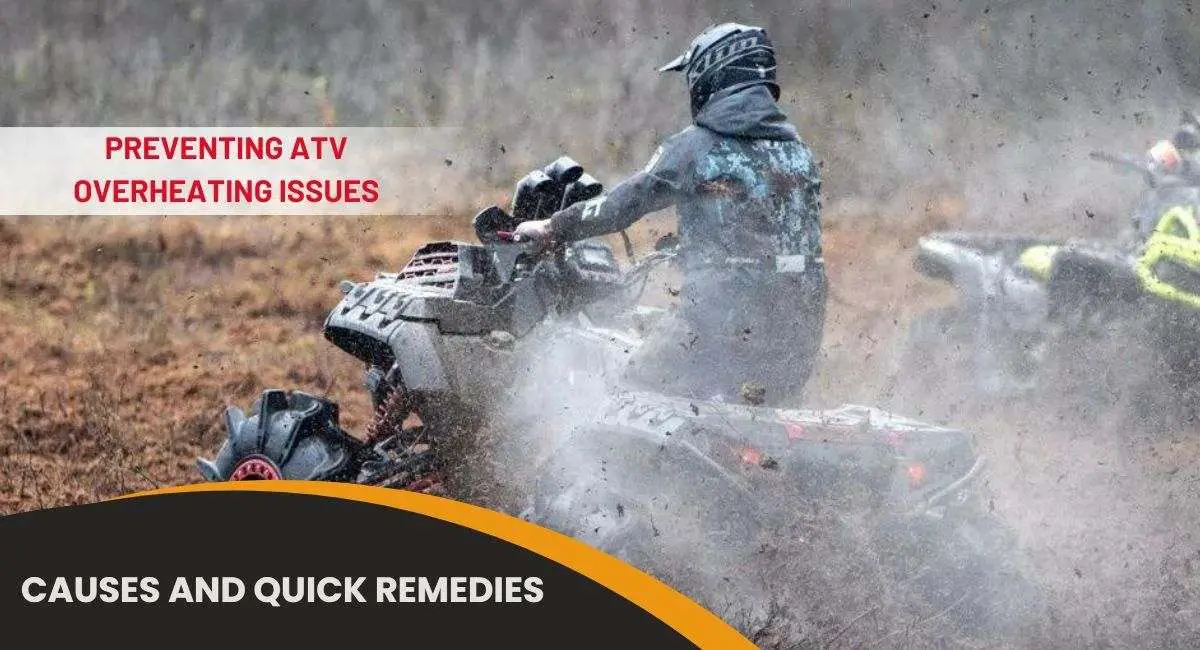As summer kicks in, more and more off-roaders are looking for ways to get the most out of their ATVs. However, the hot weather comes with its share of challenges, with overheating being a common concern.
Ideally, ATV overheating can quickly turn a thrilling ride into a frustrating ordeal. Not only does it compromise performance and comfort, but it can also lead to costly repairs and safety hazards. Therefore, understanding how to prevent ATV overheating is important for ensuring the reliability of your vehicle.
Key Takeaways
- Implementing a consistent maintenance schedule, including checking coolant levels, inspecting the radiator, and cleaning air filters, is crucial for preventing ATV overheating.
- You may also want to optimize airflow around the ATV by installing aftermarket fans or vents and avoiding obstructions to reduce the risk of overheating.
- Always practice safe riding habits to minimize strain on the engine and reduce the likelihood of overheating. This includes taking breaks in hot weather and avoiding overloading the ATV with passengers or cargo.
- Consider upgrading the ATV’s cooling system with aftermarket solutions, such as high-performance radiators and auxiliary fans to provide added protection against overheating.

Causes of ATV Overheating
Radiator Issues
The primary function of the radiator is to dissipate heat from the engine coolant. Now, any issues with the radiator can compromise its ability to regulate engine temperature effectively, leading to overheating. Some of the common radiator issues that ATV owners may encounter include;
Clogged Radiator
Accumulation of dirt, mud, debris, or insects can obstruct the radiator fins, limiting airflow and reducing its cooling efficiency. This can lead to overheating, especially if the ATV is exposed to challenging environmental elements.
Leaks
The radiator can also develop leaks due to corrosion, physical damage, or worn-out seals. Leaking coolant reduces the system’s capacity to regulate engine temperature, resulting in overheating.
Corrosion
Corrosion within the radiator can degrade its internal structure, leading to reduced coolant flow and heat dissipation. Corrosion can be caused by old coolant or exposure to corrosive substances.
Broken or Bent Fins
The radiator fins are responsible for dissipating heat, but they can bend or get damaged due to impact from rocks, branches, or debris encountered during off-road riding. If the fins are broken or bent, they can restrict airflow through the radiator, thereby impairing its cooling capacity.
Faulty Radiator Cap
The radiator cap plays a crucial role in maintaining system pressure and preventing coolant loss. A faulty or improperly sealed radiator cap can lead to coolant leaks or inadequate pressure, resulting in overheating.
Blockages in the Cooling System
In addition to the radiator, blockages can occur in other components of the cooling system, such as hoses, the water pump, or the thermostat. These blockages can restrict coolant flow, thereby impeding the cooling process and causing overheating.
Fan Problems
The work of the fan is to complement the natural airflow through the radiator, especially in situations where airflow is limited. If there is any issue with the fan, it can affect the cooling efficiency of the radiator, leading to overheating issues. Common fan problems include;
Faulty Fan Motor
The fan motor is responsible for powering the cooling fan, which draws air through the radiator to dissipate heat. If the motor is faulty, it can result in the fan not operating at all or functioning intermittently, leading to inadequate cooling.
Damaged Fan Blades
If the fan blades become compromised, they may not generate sufficient airflow, thereby reducing the cooling capacity of the fan. This can result from impact from debris or mechanical stress.
Fan Relay Failure
The fan relay controls the flow of electrical current to the cooling fan. If the relay fails, the fan may not receive power, causing it to remain inactive even when the engine temperature rises. This can lead to overheating, especially in hot weather or heavy load conditions.
Blockages
Blockages around the fan can obstruct airflow and impede fan operation. This can, in turn, prevent effective heat dissipation and increase the risk of overheating, particularly during off-road riding.
Low Coolant Levels
Coolant helps regulate engine temperature by absorbing heat from the engine and transferring it to the radiator for dissipation. When coolant levels are low, the cooling system may not have enough fluid to absorb and dissipate heat effectively, leading to overheating. Low coolant levels can be caused by;
Leakage
Coolant leaks can occur primarily due to worn-out hoses, seals, gaskets, or a damaged radiator. These leaks lead to a gradual reduction in coolant levels, thus compromising the cooling system’s ability to regulate engine temperature.
Evaporation
Coolant can evaporate from the system, especially in hot climates or when the ATV is exposed to prolonged periods of idling. Evaporation reduces coolant levels gradually, eventually reaching a point where there’s insufficient coolant to cool the engine.
Incomplete Filling
If the system isn’t filled to the recommended level, there won’t be enough coolant circulating to absorb and dissipate heat, thus increasing the risk of overheating.
Coolant Degradation
Coolant can degrade over time due to factors, such as age, exposure to high temperatures, or contaminants. Degraded coolant lacks the ability to absorb and transfer heat, leading to reduced cooling efficiency.
Water Pump Failure
The water pump plays a critical role in the cooling system by circulating coolant throughout the engine and radiator, thereby facilitating heat transfer away from the engine components. If the water pump fails, coolant circulation is impeded, leading to elevated engine temperatures. Common causes of water pump failure include;
Worn Bearings
Water pump bearings can wear due to normal wear and tear or inadequate lubrication. Worn bearings can make the water pump shaft become misaligned or seize, leading to reduced efficiency or complete failure of the water pump.
Corrosion
Corrosion can occur inside the water pump housing due to exposure to coolant, minerals in the water, and other contaminants. As a result, the pump can undergo pitting, erosion, or blockage, thus hindering coolant flow.
Impeller Damage
The impeller is responsible for circulating coolant through the engine and radiator. Any physical damage to the impeller can impair its ability to move coolant effectively, resulting in reduced coolant flow and overheating.
Signs of ATV Overheating
Increased Engine Temperature
An overheating engine may show a higher-than-normal temperature reading or trigger a warning light on the instrument panel.
Steam or Vapor
If coolant begins to boil due to overheating, it may produce steam or vapor visible near the radiator or engine compartment.
Reduced Performance
An overheating engine may experience decreased power output, poor throttle response, or engine misfires. Always pay attention to any unusual changes in the ATV’s performance, such as sluggish acceleration or difficulty maintaining speed.
Boiling Coolant Overflow
In severe cases of overheating, coolant may boil and overflow from the radiator or coolant reservoir. This is characterized by coolant splatter or overflows around the radiator cap or reservoir.
Unusual Engine Noise
An overheating engine may produce unusual noises such as knocking, pinging, or rattling due to increased friction and stress on engine components.
Visible Coolant Leaks
Inspect the ATV for signs of coolant leaks, such as puddles or stains beneath the vehicle, dampness around hoses or connections, or visible coolant dripping from the radiator or engine.
How to Prevent ATV Overheating
Keep Coolant Levels in Check
Monitor and maintain the coolant levels in your ATV’s radiator regularly. Proper coolant levels are key for efficient heat dissipation and preventing overheating. Consider incorporating a recovery tank into your ATV’s cooling system to collect excess coolant. This allows for efficient coolant circulation and prevents air pockets that can lead to overheating.
Inspect Radiator for Debris
After each ride, take a moment to inspect your ATV’s radiator for any debris buildup. Ensure to clear away dirt and mud from the radiator fins to facilitate unrestricted airflow and optimal cooling performance.
Mind Your Air-Cooled Engine
If your ATV is equipped with an air-cooled engine, be mindful of idling for extended periods, especially in hot weather. Always shut down the engine during stops to help prevent heat buildup and component damage.
Maintain Optimal Speed
Ride at an appropriate speed to ensure sufficient airflow through the radiator for effective heat dissipation. Avoid prolonged operation at low speeds or excessive throttle use, which can increase engine temperature.
Upgrade to a High-Pressure Radiator Cap
Consider upgrading your ATV’s cooling system with a high-pressure radiator cap. This will help provide added cooling efficiency, particularly on scorching summer days.
Invest in Quality Water Pump Components
Upgrade your ATV’s water pump and impeller with aftermarket options to ensure reliable coolant circulation. Aftermarket water pump components are designed to maintain consistent engine temperatures, which can, in turn, prevent power loss due to overheating and optimize engine performance.
Select Shaded or Open Trails
Choose riding routes that offer ample airflow and shade, especially in hot weather. Avoid densely wooded areas or trails with thick vegetation that can obstruct airflow and contribute to overheating.
Prioritize Summer Maintenance
While winter preparation is common, don’t overlook the importance of summer maintenance for your ATV. Servicing the cooling system and other vital components regularly can save you money and prevent problems down the road. Furthermore, be mindful of riding in extreme weather conditions that can strain the cooling system and increase the risk of overheating.
Steps to Take After ATV Overheating
- As soon as you notice signs of overheating, safely pull over to the side of the trail or a flat, level area away from traffic or obstacles.
- Turn off the ATV’s engine to prevent heat buildup and further strain on the cooling system. Allow the engine to cool down before attempting to diagnose the issue.
- Once the engine has cooled down, carefully check coolant levels in the radiator or coolant reservoir. If coolant levels are low, add coolant to the appropriate level.
- Look for signs of coolant leaks, such as puddles or stains beneath the ATV or visible coolant dripping from the radiator or hoses.
- Open the ATV’s hood or panels to allow heat to dissipate more quickly. Avoid touching hot engine components.
- If available, carefully pour water over the radiator to help dissipate heat and cool the engine more quickly. Use caution to avoid burns from hot surfaces.
- Allow the engine to cool down sufficiently before attempting to restart the ATV. Restarting the engine too soon could exacerbate overheating and cause further damage.
The Parting Shot
Off-roading has become increasingly popular thanks to the accessibility of outdoor adventures. However, with this thrill comes the responsibility to ensure the safety and reliability of our vehicles, especially during summer heat. If your ATV is prone to overheating it’s important to stay informed about proper maintenance practices and invest in upgrades that ensure your ATV adventures remain fun and trouble-free.




